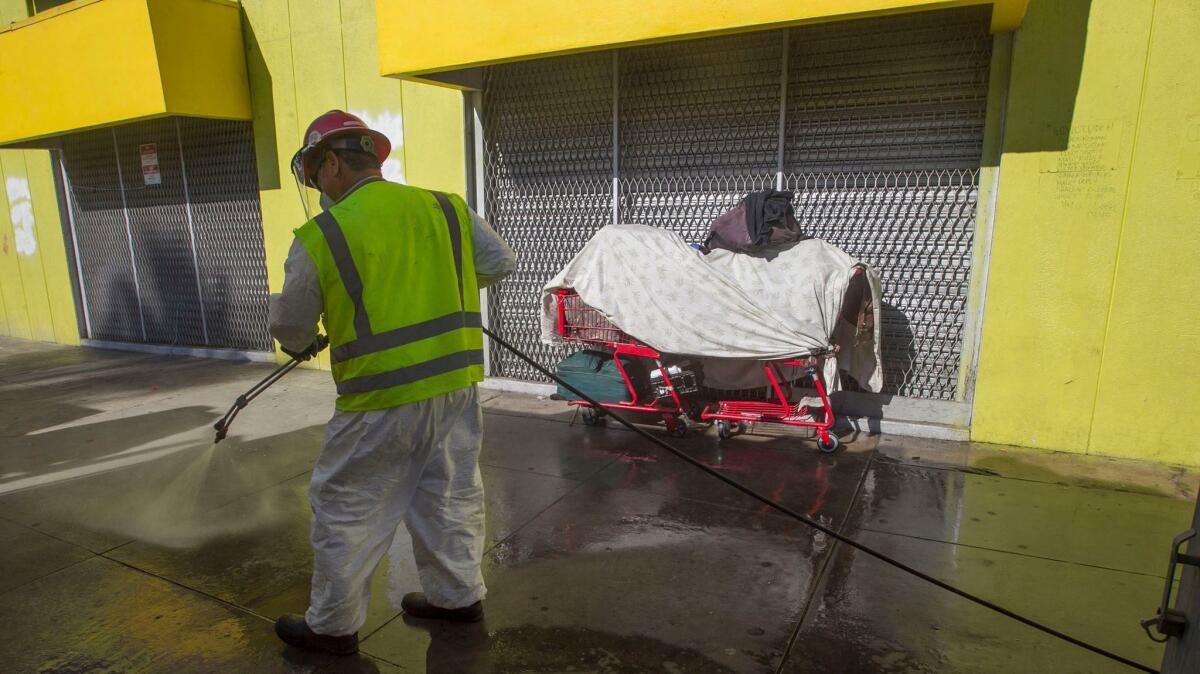Editorial: Let’s not make sidewalk cleanings an excuse to force homeless people off the sidewalks

Cleaning a filthy sidewalk seems like such a simple and important thing. But it’s not that simple if that sidewalk is someone’s home.
Before the pandemic gripped Los Angeles, it was not unusual for the city Bureau of Sanitation to power-wash and disinfect sidewalks. The process was often problematic, though, resulting in standoffs between sanitation workers and homeless people in encampments. Homeless people often lost important possessions or had them confiscated by sanitation workers during cleaning sweeps.
In March, with a public health crisis looming, the City Council barred city workers from seizing homeless people’s belongings or forcing them to take down their tents. That was consistent with guidance from the Centers for Disease Control and Prevention, which recommended that cities “allow people who are living unsheltered or in encampments to remain where they are” if housing options weren’t available. Otherwise, clearing encampments would disperse homeless people into communities and increase the potential for contracting and spreading COVID-19. Meanwhile, the sanitation bureau stopped doing the deep cleanings that required tent removal. The city also took the long-overdue step to set up handwashing stations and portable toilets near encampments.
But this month, the City Council voted 10 to 4 to resume deep cleanings — the kind that involve clearing tent encampments in order to power-wash the sidewalks — specifically in the blocks around the shelters that are part of the city’s “A Bridge Home” program.
So what’s changed since March? Nothing but the politics — and the desire on the part of some council members to appease constituents irritated by homeless encampments.
Two years ago, when Mayor Eric Garcetti proposed “A Bridge Home” shelters across the city (there are now 20 with nearly 1,600 beds), he promised that in exchange for neighborhoods accepting these shelters, the city would keep the surrounding blocks free of encampments. But the city stopped most of that enforcement after a federal court decision declared it unconstitutional to force homeless people to move off a sidewalk when there were not enough shelter beds. And, more recently, a federal court injunction barred the city from removing homeless people’s belongings just because they’re big and bulky.
No one wants homeless people living on sidewalks in tents. And no one wants to let sidewalks stay filthy. But during a public health crisis, we are left with a grim choice: let streets remain dirty or clean them and put homeless people, already vulnerable, at more risk by forcing them to uproot their tents and wander the city looking for another sidewalk to bed down on.
We should always be trying to get people into shelter or housing. But even in the areas surrounding bridge shelters, where cleanings are resuming, there won’t necessarily be enough beds in those shelters for everyone. Nor will everyone want to go, given the risks faced today by people in large shared living spaces. Of the nearly 1,200 homeless people in L.A. County who contracted COVID, 439 were in a shelter at the time they were thought to have been exposed, according to county officials.
So let’s do these cleanings as carefully as possible. The mayor’s office and the Bureau of Sanitation say there will be protocols for protecting homeless people who are required to move. Let’s make sure they are followed. Sanitation officials say that homeless people won’t be asked to move far from the cleaning site or stay away longer than the cleaning takes. They will also be provided with services: mobile showers, a tent exchange, toiletries, first aid, and COVID testing by L.A. Fire Department personnel.
How about doing the testing at encampments a week ahead of the cleanups? That way, city officials will know if the encampment dwellers are healthy before they start asking people to move. If not, officials can postpone the cleanup and try to isolate whoever has tested positive.
Sanitation officials say they plan to do these deep cleanings once a week. That sounds like an attempt to disrupt encampments so often that people stop returning and simply go elsewhere. And that’s exactly what public health officials say we don’t want during the pandemic.
How about just cleaning a sidewalk when it needs it? Why not give homeless people brooms so they can do it themselves? None of these deep cleanings should be a substitute for making sure that trash receptacles are placed at all encampments and regularly emptied by sanitation workers. Just like house dwellers have their trash picked up every week, homeless people should have theirs picked up as well. These Angelenos may be homeless, but they’re not helpless.
More to Read
A cure for the common opinion
Get thought-provoking perspectives with our weekly newsletter.
You may occasionally receive promotional content from the Los Angeles Times.










